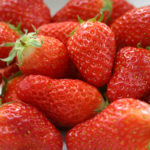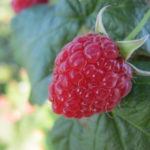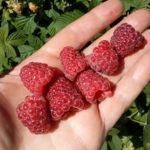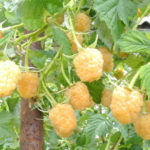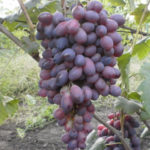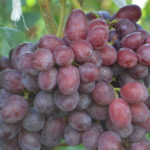Raspberry variety Krepysh
In recent decades, standard varieties of raspberries, or as they are popularly called "raspberry trees", have become widespread in our garden and garden plots. Plants deserve such an unusual epithet of this type for their unusual appearance. Being, in essence, the same shrub as ordinary raspberries, "trees" are distinguished by powerful erect annual shoots, on the tops of which, with the help of simple manipulations, you can form a kind of "crown", on which a rich harvest of berries will be obtained next year.
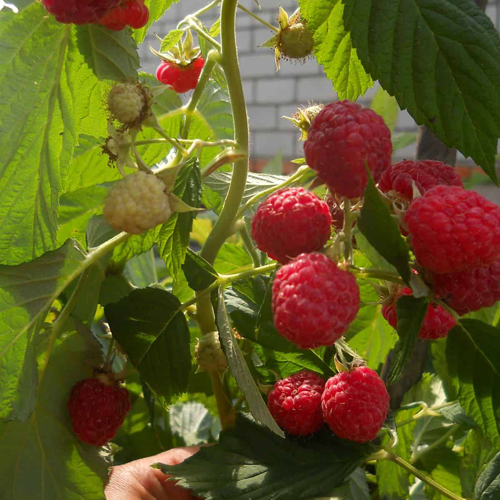
The advantages of these varieties are obvious. Firstly, the plants, despite their rather high growth, do not need supports and trellises, which greatly simplifies their care. Secondly, the yield of "trees" is much higher than ordinary bushes due to the large number of branches in the "crown", which are dotted with large fruits, often exceeding the size of the berries of traditional varieties. In addition, the standard raspberry demonstrates the best unpretentiousness and resistance to unfavorable environmental factors, in comparison with ordinary bush cousins.
An important role in the selection of this culture in general, and its standard varieties in particular, was played in our country by the famous researcher, Honored Scientist of the Russian Federation V.V. Kichina. Heading the department of genetics and selection of the leading research institution in the field of horticulture of the Non-Black Earth Belt - VSTiSP, Viktor Valerianovich has developed many new varieties of raspberries, including a whole line of "raspberry trees", among which a species called Krepysh occupies a worthy place. She was born at the beginning of the 2000s and very soon gained popularity and recognition by many amateur gardeners. In addition to the positive qualities common to the standard varieties, our hero is distinguished by the absence of thorns on the shoots, a prolonged fruiting period, excellent gastronomic and aesthetic properties of fruits, as well as their remarkable transportability.
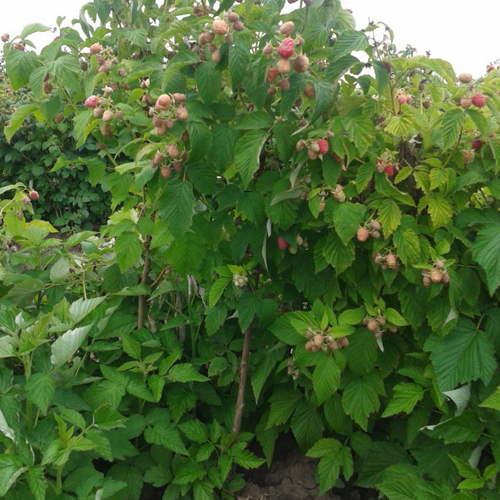
And even though Krepysh has not yet gained official recognition and his name is not listed in the State Register of varieties admitted for cultivation on an industrial scale, people's love for him means much more. Consequently, the work of the famous breeder was not in vain.
Agrobiological characteristics
The dimensions of the raspberry bushes are quite impressive due to the significant number of powerful erect shoots, the height of which ranges from 1.4 to 1.8 meters. The diameter of the stems is impressive - 1.5-2 cm, they themselves are tough and durable, for which our hero, obviously, got his name. The internodes on the shoots are very short, and therefore the plants turn out to be well leafy, and in the fruit zone numerous branches develop, on which berries grow abundantly. Leaf growth begins at a distance of 30-40 cm from the ground surface. The number of replacement shoots is small - as a rule, it does not exceed 8-10 per plant. Root offspring are also poorly formed, which, on the one hand, makes it easier to keep the raspberry tree in a neat condition, and on the other hand, it somewhat complicates reproduction. The variety is non-repairable, fruiting occurs on biennial shoots as in the classic varieties. Young shoots are thornless, with a smooth skin, light green and covered with a noticeable layer of waxy bloom. After ripening in autumn, their color changes to pine-yellow. Krepysh's leaf blades are large, rich green, have a rough, highly corrugated surface, collected in trifoliate odd-pinnate leaves. At the tops of the shoots, they grow in crowded bunches.
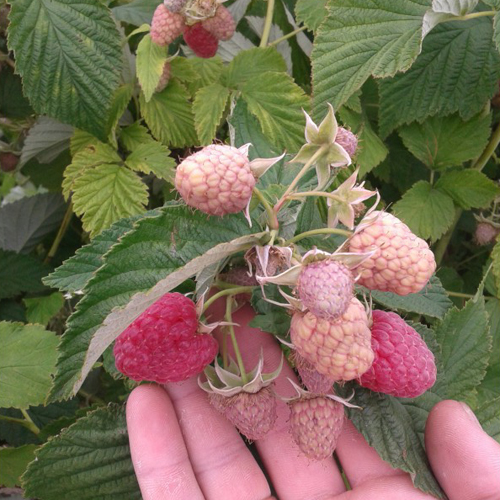
Raspberry bloom begins in the first decade of June, when white flowers of not very large size, usually less than 1 cm in diameter, open on the laterals (fruit branches). They are collected in rather large branching brushes.Fertilization happens very well in almost any weather. This is also due to the fact that the flowers are turned with their cups down, and even during the rain, bees have the opportunity to collect nectar under these natural "umbrellas", while pollinating the plants. The ripening period of Krepysh berries may differ depending on the climatic conditions of the region and the weather in a particular season, but usually falls in the month of July. At the same time, the crop does not mature at the same time, and the fruiting period can stretch for 10-15, or even more days. Ripe berries do not crumble, and can remain on the bushes for a long period of time, gradually losing moisture and drying out. Overripe fruits are easy to collect, but they become quite tender and can crumble to pieces due to inaccurate handling. The total productivity of the variety, with an appropriate level of agricultural technology, can reach 3-4 kg of raspberries per bush or 180-200 c / ha.
One brush can contain up to nine ovaries, they rapidly gain in size just before the onset of ripeness, reaching an average weight of 7-10 grams. The color of the fruits of Krepysh is bright red, the shape is blunt-conical. They taste sweet and sour, have a rather intense aroma typical of the culture. The flesh of the berries is dense, but at the same time, quite juicy inside, which allows them to combine excellent indicators of transportability and attractiveness of appearance with high tasting characteristics. The average sugar content of the juice is about 6.8-7.2%, the content of titratable acids is no more than 2%. The total share of dry matter reaches 11%. Seeds are few in number, and their presence does not adversely affect the palatability of raspberries.
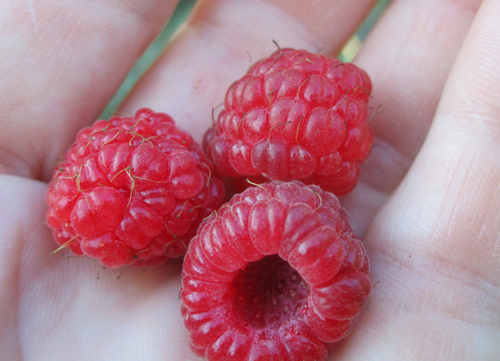
The crop is used in a wide variety of ways. First of all, it is excellently perceived when consumed fresh. The large size of the berries, their excellent taste and attractive appearance determine the excellent marketability of the variety. In this regard, farmers often cultivate Sturdy for commercial purposes, receiving a good income from high-yielding bushes. This variety also opens up wide possibilities as a raw material for processing. It is used to prepare wonderful jams, rich in vitamins and microelements, jams, marshmallows, juices and compotes. You can insist on strong alcoholic drinks on raspberries, and use it to make liqueur, berry wine or liqueur. Dried fruits are also obtained from this variety of very high quality.
The economic characteristics of our hero do not lag behind the gastronomic ones at all. The bushes are distinguished by increased frost resistance, which the author of the variety tried to instill in all his offspring. The maximum level of winter cold, which the bushes can withstand without damage, reaches -30 ° C. In addition, raspberries are resistant to many fungal and viral diseases, which can significantly reduce the number of chemical treatments of plants and get an environmentally friendly harvest. The drought resistance of the bushes is average, while they respond very well to regular watering in regions where there is a shortage of rain moisture. Demanding soil conditions are not too high. Unsuitable soils for cultivation are swampy, overly acidic silt, saline, water- and air-tight areas, as well as lands with a very close to the surface groundwater table.
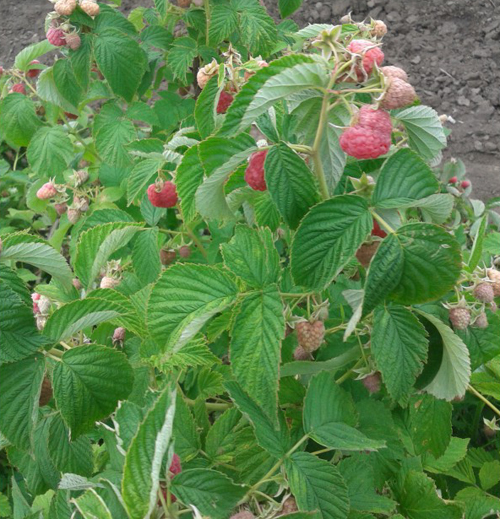
Agrotechnical features
Standard forms of raspberries, including Krepysh, during cultivation require a certain specificity in terms of shaping, while otherwise they behave in the same way as ordinary non-repair varieties that bear fruit on biennial shoots.
If we are talking about commercial plantings, then they approach the choice of a site with all responsibility, trying to fully meet the needs of this crop, and providing a high agricultural background to obtain the maximum possible yields. In particular, from the point of view of the terrain, in sufficiently humid regions it is better to use gentle slopes of warm exposures, while with regularly recurring dry periods, lowered plains or slopes of northern directions are preferable.Possible extremes should be avoided, for example, planting in damp beams, or hollows in which cold air stagnates, or vice versa - on heights from which snow is blown off in winter, leaving plants bare, face to face with frost. Also, agronomists do not recommend using the incinerating southern slopes for raspberries, where not only do the plants “burn” in summer, but also in the cold season they often freeze out after short thaws, “crumpling” in the deceptive winter sun.
Planting of the variety is carried out in rows according to the recommended scheme of 1.5-2 × 0.5-0.7 m, or in separate bushes. The planting holes are filled with mineral and organic fertilizers, and after covering the roots of plants with earth, they carry out abundant watering. The raspberry tree can be laid in early spring or autumn. In the latter case, it is imperative to wait for the leaves to fall.
Caring for fruiting raspberry bushes consists, first of all, in pinching young shoots when they reach a height of 1.5 meters. It is this procedure that leads to the formation of a full-fledged "tree" from Krepysh with numerous fruit branches, which are the key to a rich harvest. In addition, on the plantations, they carefully fight against emerging weeds, carry out watering and fertilizing if necessary, cut off the sprouted shoots in time and carry out preventive spraying against pests and diseases. The productive period of plants lasts for ten years, after which the plantation must be renewed.
